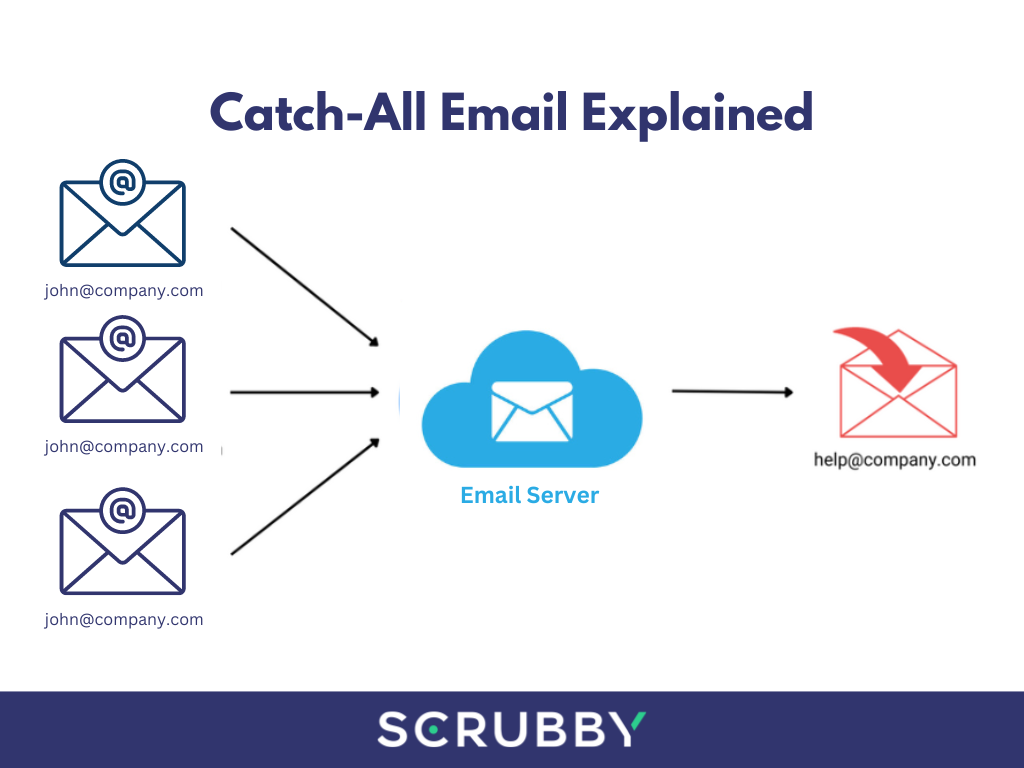Catch-all email addresses are a handy tool for businesses to ensure all emails sent to their domain are received, but they pose a significant challenge for marketers. Here’s what you need to know about catch-all emails and how to handle them effectively. Catch-all inboxes are often overlooked, leading to emails being sent to addresses that aren’t actively checked. This can result in zero engagement and, if the inbox is full, your messages may bounce back.
For email marketers, this is a serious issue. Poor engagement and high bounce rates can negatively affect your email deliverability. However, there are strategies to mitigate these problems. Continue reading to learn why businesses use catch-all email addresses, the challenges they present, and the straightforward steps you can take to identify and manage these addresses.

What are Catch-All Email Addresses?
A catch-all email address, also known as a wildcard email address, is designed to receive all emails sent to a domain, regardless of whether the recipient’s address exists. For instance, if your domain is example.com, a catch-all email address will capture emails sent to anyaddress@example.com, whether anyaddress is a legitimate address or a typo.
Catch-all addresses are configured at the domain level and can be particularly useful for ensuring no email is missed, even if sent to an incorrect or non-existent address.
The Purpose of Catch-All Emails
The primary purpose of a catch-all email address is to ensure that all email communications reach your domain, minimizing the risk of losing potential leads or important messages. In the context of lead generation, every email counts, and missing out on any communication can translate to missed business opportunities.
Catch-all email addresses serve several purposes:
- Error Handling: They catch emails sent to incorrect or mistyped addresses, ensuring communication isn’t lost.
- Customer Service: They ensure that customer queries or feedback sent to any address within your domain are received and addressed.
- Spam Management: They help in identifying spam and filtering it effectively before it reaches individual inboxes.
How Common are Catch-All Emails?
Catch-all email addresses are fairly common among businesses that prioritize seamless communication. They are especially prevalent in industries that rely heavily on email marketing, customer service, and lead generation.
For lead-generation agencies, having a catch-all address ensures that no potential lead is lost due to a simple typographical error. However, their usage is balanced with the need to manage and verify the incoming emails effectively to avoid being overwhelmed by spam or irrelevant messages.
Benefits of Catch-All Emails
Catch-all email addresses offer several benefits:
- Comprehensive Coverage: They ensure that no email sent to your domain is lost, regardless of address errors.
- Improved Customer Experience: By capturing all incoming emails, you can respond to customer inquiries more effectively, enhancing customer satisfaction.
- Lead Maximization: In lead generation, every contact counts. Catch-all addresses help maximize potential leads by ensuring all emails are received.
Using a tool like Scrubby can amplify these benefits by validating the catch-all emails, ensuring they are from legitimate sources and reducing the burden of managing spam or irrelevant emails.
Disadvantages of Catch-All Emails
Despite their benefits, catch-all email addresses come with some drawbacks:
- Increased Spam: Catch-all addresses can become magnets for spam emails, as they accept all emails sent to the domain.
- Resource Intensive: Managing and filtering through a large volume of emails can be resource-intensive, requiring robust spam filters and validation tools.
- Potential for Overwhelm: Without proper management, the sheer volume of emails can overwhelm your system, leading to important messages being missed or delayed.
To mitigate these disadvantages, using an email validation tool like Scrubby is crucial. Scrubby helps in filtering out spam and validating the authenticity of incoming emails, ensuring your catch-all address works efficiently.
How to Verify Catch-All Emails
Verifying catch-all emails is a critical step in managing your email communications effectively. Here’s how you can do it:
- Use an Email Validation Tool: Scrubby offers specialized services for verifying catch-all emails. It checks the validity of the sender’s address and filters out spam, ensuring only legitimate emails reach your inbox.
- Implement Spam Filters: Use advanced spam filtering systems to reduce the influx of unwanted emails.
- Monitor Email Activity: Regularly monitor the activity of your catch-all email address to identify patterns and potential spam sources.
- Set Up Whitelists and Blacklists: Maintain lists of trusted senders and known spammers to streamline email management.
- Regular Audits: Conduct periodic audits of the emails received through your catch-all address to ensure the system works efficiently.
Scrubby simplifies the validation process, providing a reliable solution for managing the influx of emails and ensuring your communication channels remain clear and efficient.
Conclusion
Catch-all email addresses are invaluable for businesses, especially lead-generation agencies, ensuring no communication is lost due to incorrect email addresses. They offer significant benefits, including comprehensive email coverage and improved customer service, but also come with challenges like increased spam and resource demands.
To harness the full potential of catch-all email addresses while mitigating the downsides, using a reliable email validation tool is essential.. By integrating Scrubby into your email management system, you can enhance the efficiency of your communication channels, ensure all legitimate emails are captured, and focus on what truly matters—growing your business.
Ready to streamline your email communications and maximize your lead-generation efforts? Try Scrubby today and experience the difference a reliable email validation tool can make.